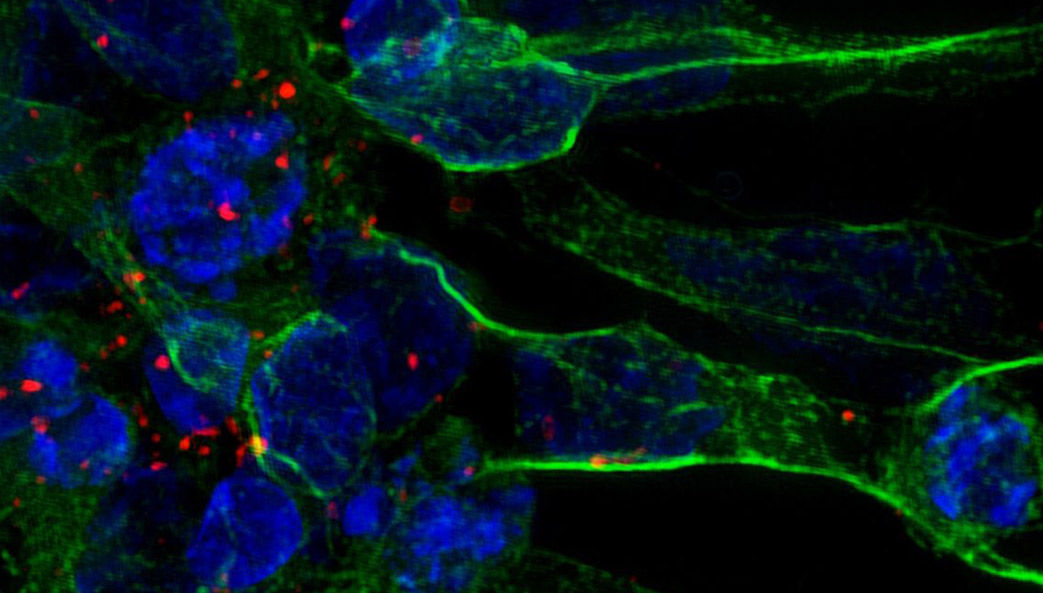A new combination therapy developed at the University of Georgia’s Regenerative Bioscience Center (RBC) has shown promising results in models of ischemic stroke, or strokes caused by blood clots, significantly reducing disability within a three-month period.
Building on more than a decade of work using pig models for stroke research and induced pluripotent stem cell-derived neural stem cells (iNSCs), Professor Franklin West and a research team including Jin Xie, a professor in the Department of Chemistry at UGA’s Franklin College of Arts and Sciences, have determined that adding drug-loaded nanoparticles containing the anti-inflammatory compound Tanishinone IIA (Tan IIA) to iNSCs significantly improves outcomes in ischemic stroke pig models.The study has been published in the journal Stem Cells Translational Medicine. Work on the study was supported by doctoral students Erin Kaiser, Elizabeth Waters and Xueyuan Yang.
Toxic environment
“After your brain has a stroke, many cells die and there is an overall decrease in performance in the cells that survive. There is also a decrease in the way the blood flows around the brain, called perfusion. But with the stem cell treatment, this improved,” West said. “The problem was, when you transplant the cells, they are being introduced into an environment that’s really cytotoxic and it leads to higher levels of cell death.”
Of approximately 10 million iNSCs transplanted, less than 10% of the cells survive to develop into other types of brain cells, he added.
“When there is a brain injury, all these white blood cells are rushing to the site of injury to try to repair the damage and they produce what we call inflammatory cytokines. Those cytokines promote cell death, so when we put these neural cells in, there is all this cell signaling to tell those cells to die,” West said.
Adding the TAN II-A nanoparticles is meant to address that intense cytokine response, which causes cells to rupture, releasing free radicals into the brain, West said, likening the dump of free radicals into the body after a stroke to a nuclear reactor melting down.
“The mitochondria of your cell, though it is the powerhouse of the cell, generates a lot of free radicals, but it’s in a controlled environment. It’s kind of like a nuclear reactor — it’s great when the energy is in the reactor, but if it explodes, you’re in trouble,” he said. “They just spill toxic waste all over the place.”
Plant-based medicine
Collage of the three graduate students who worked on the study in the West Lab.
From left, doctoral students Erin Kaiser, Elizabeth Waters and Xueyuan Yang worked on the ischemic stroke study.
West worked with Jin Xie, a professor of chemistry in the Franklin College of Arts and Sciences, to develop nanoparticles containing TAN-IIA, an anti-inflammatory, anti-oxidative compound derived from the root of Salvia miltiorrhiza, also known as danshen, which is used in traditional Asian medicine and has been widely studied for use in the treatment of a variety of diseases.
While the compound was traditionally used as a tea derived from danshen root, West and Xie used a more concentrated form.
“We decided to put this in a nanoparticle and inject it to allow for the bioactive component of it to be available to the brain for extended periods of time” to give the compound the opportunity to reduce the inflammation and free radicals present around the site of the injury, West explained. By using the nanoparticles, the compound slowly releases over 72 hours.
To encapsulate the drug, Xie used PLGA, or poly(lactic-co-glycolic acid), an FDA-approved polymer for clinical drug delivery.
“The idea was to use a nanoparticle to encapsulate the drug so we can control the release of the therapeutic over time, otherwise the drug tends to have a short circulation period and is cleared away rapidly,” said Xie, whose research has focused on nanoparticle drug delivery in cancer treatment.
For the study, 22 subjects were randomly divided into three groups — one treated with iNSCs alone, the second treated with the TAN IIA infused nanoparticles plus iNSCs and a control group that received no therapeutic treatment.
Over the course of the 12-week study, researchers used magnetic resonance imaging (MRI), a Modified Rankin Scale (mRS) neurological evaluation, and lab tests to determine whether the injected iNSCs were developing into neurons.
“Giving the nanoparticles, then transplanting the stem cells, we were hopefully going to improve outcomes. And when we did that, it doubled the number of stem cells that integrated into the tissue,” West said.
Essentially, the TAN IIA nanoparticles reduced the stroke damaged brain toxicity to enable better iNSC survival and engraftment. By reducing the inflammatory response in the brain, the treatment also reduces the scarring that can inhibit natural brain recovery. The iNSCs then develop into neurons, replacing damaged cells in the region around the core injury.
Dramatic results
Professor Franklin West sets up the stereotaxic injector in the animal surgery suite of the Edgar Rhodes Center for Animal and Dairy Science.
West sets up the stereotaxic injector in the animal surgery suite of the Edgar Rhodes Center for Animal and Dairy Science.
Results at 12 weeks post-treatment showed that administration of TAN IIA nanoparticles increased iNSC engraftment post-stroke, promoted replacement of damaged tissue post-stroke and reduced the number of killer immune cells that signal cells to die.
In addition, the pigs who received the TAN IIA+iNSCs treatment decreased lesion volumes in the damaged areas of the brain, reduced intracerebral bleeding and reduced midline shift, which is the displacement of brain tissue across the natural center line of the brain after injury due to intracranial pressure from swelling and a buildup of fluids.
“We can improve engraftment by using nanoparticles and it’s not just going to be a small bump. It’s supercharging the event,” West said.
In addition to the improved brain conditions with TAN IIA+iNSCs treatment, pigs receiving the combination showed significantly reduced Modified Rankin Scale (mRS) scores and a significant improvement in functional recovery within two days of receiving treatment, to include walking independently and eating and drinking with assistance, compared to pigs that received no treatment.
“We’re using a human scale where zero means there are no symptoms — you’re completely normal — and six means you’re dead. It’s a pretty clear metric,” West said.
Pre-stroke, all of the subjects were at a mRS score of zero. Afterward, all of the test subjects registered at an average of five on the scale. At 12-weeks post procedure, the subjects receiving no treatment showed very little progress past a three on the scale. Subjects receiving only the iNSCs treatment improved to between a two to a three on the scale, with two indicating slight disability.
For subjects receiving the TAN IIA+iNSCs treatment, subjects scored between a one and a two on the scale, which indicates a range from no significant disability to slight disability.
“In humans, once you hit that three-month time point, whatever improvements that are going to occur are probably going to be incremental improvements. This is kind of like the golden window — you try to achieve as much improvement as possible because it is as good as it’s going to get after that window,” West said. “At the severity level of stroke patients that we are discussing, about 60% must have some in-home care, meaning a nurse comes to their house and has to feed them and help them dress. If you could improve that to being slightly disabled up to having no significant disability, that’s a game changer.”
West is eager to advance the research to human clinical trials and is hoping to partner with a biomedical company pursuing stroke therapeutics to push the work forward.
“We are also pushing this forward in some other areas, like traumatic brain injury, as we could potentially expect similar results,” said West.






